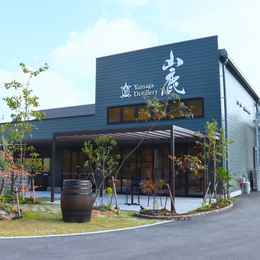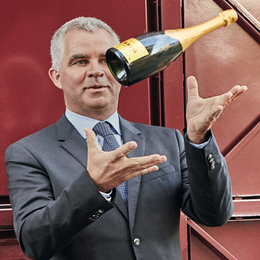This Is Taittinger Champagne: The House That Produces Happiness And Not Just Champagne

"I am a happiness producer. Figures do not interest me," Pierre-Emmanuel Taittinger, the previous head of French champagne maker Taittinger, once declared in a period following a hard fought battle to buy back the esteemed Champagne House from a US private equity firm.
Talk about Champagne, and one is bound to run into the name Taittinger (tay -tuhn - juh). Taittinger Champagne is the third largest grower in the Champagne region, and one of its most renowned and historic. From operating out of a mansion once used by French royalty, to offering a Champagne line featuring the seal of a Count, to being subject of a cross-broder private-equity buyout that had the Champagne industry in arms, this Champagne house certainly has a story to tell.
The Taittinger Family Founded Their Business In A House Used By Royalty

Château de la Marquetterie.

In 1932, a Parisian soldier called Pierre Taittinger bought the Chateau de la Marquetterie from the wine house of Forest-Fourneax. This wasn’t just any old mansion! You see, this place used to be the home of Theobald I of Baverre, a young Count of Champagne who was previously credited with bringing the Damask rose and Chardonnay grape variety to the Champagne region (a folklore that has since been disproved using genetic analysis).
The Taittinger family themselves were originally wine merchants from Lorraine who relocated to the Paris region in 1870.

Later on, Pierre’s son Francois Tattinger took over the reins. This handover signaled an important turning point for the Champagne House. Ever the forward-thinking man, Francois was heavily focused on planning the future of the champagne house and ensuring its continued success. He quickly recognised the presence of growing international competition and an urgent need to cement their presence in the related markets.
To that end, he added the family name to the brand of their Champagnes, solidifying Taittinger's identity in the market.
Maison Taittinger Is a House With A Whole Lot Of Hectares, Being the Third Largest Domaine in Champagne
With little over 288 hectares of vineyards, the house holds the distinction of being the third largest domaine in Champagne.
The vineyards of Château de la Marquetterie itslef have a rich history dating back to the 18th century. Originally planted with Chardonnay and Pinot Noir grapes, the property was developed by Brother Jean Oudart, a Benedictine monk and one of the pioneers of Champagne winemaking.

The whopping 288 hectares are located between the Côte des Blancs, Vallée de la Marne and the Montagne de Reims wine regions. The vineyard comprises 37 per cent Chardonnay, 48 per cent Pinot Noir, and 15 per cent Pinot Meunier vines, spread across 37 different crus. Notably, 95 per cent of its vineyards in the Côte des Blancs are planted with Chardonnay vines.
The sum total of grapes produced from this area provides 45 per cent of what the Champagne House needs.
Their holdings have only expanded in recent years. In 2017, Maison Taittinger made history by becoming the first Champagne house to establish vineyards in the United Kingdom. This started as a partnership with UK wine agents Hatch Mansfield. Taittinger acquired 40 hectares of land in Chilham, Kent, in 2015 and started planting vines, finally finishing two years later.
The Cellars Of Taittinger Stands On Land Where A Church Once Was

Old plans of the St. Nicaise Abbey.
Under François Taittinger's watchful eye, the house would also come to establish its cellars. The cellars themselves are steeped in rich history; In the 13th century, Benedictine monks erected an abbey on the site of Saint-Nicaise's grave to venerate his relics. During the French Revolution, however, the abbey was sold as national property and subsequently plundered for its stone. By the 19th century, little remained on the once great church.
Despite the destruction of the above-ground structure, the ancient, underground chalk quarries dating back to the Gallo-Roman era remained remarkably preserved. It was within these tunnels that the house would store a portion of their champagne.
The Deal That Shook the French: Selling (And Buying Back) the Family Business

Pierre-Emmanuel Taittinger.
In July 2005, the Taittinger family (for reasons not entirely clear) sold Maison Taittinger and its subsidiary, Société du Louvre, to the American private investment firm Starwood Capital Group.
This decision was not well-received among industry professionals. Among their many concerns, they strongly believed that Starwood's focus on short-term profitability might not align with the long-term vision required for producing high-quality Champagne.
Aside from worries about quality and heritage, there were many within the Champagne industry that had broader concerns; that the arrival of foreign investors who were unfamiliar with Champagne's culture and traditions might disrupt a long-standing cultural balance.

The same year that Claude Taittinger retired, Pierre-Emmanuel would be the one who would re-acquire the family company for €660 million. He did so with the help of the Northeast Regional Bank of the Crédit Agricole. Almost all of the family's holdings were returned to their former owners, bar some hotels that The Starwood group retained.
Taittinger's Champagne Honors Royalty With Its Name and Seal
Among the House's many renowned offerings, one stands out in particular: Their Comtes de Champagne Cuvées.
Comtes de Champagne is a prestigious cuvée crafted from Chardonnay grapes sourced from the five Grand Cru villages of the Côte des Blancs: Avize, Cramant, Chouilly, Le Mesnil-sur-Oger, and Oger.

Comtes de champagne blanc de blancs
The most popular iteration of the cuvée is the Blanc de Blanc. Crafted exclusively from 100 per cent Chardonnay, the grapes are sourced from the five Grand Cru villages of Avize, Chouilly, Cramant, Oger, and Mesnil-sur-Oger.
On the other hand, the Comtes de Champagne Rosé is a prestigious cuvée crafted from a blend of 30 per cent Chardonnay Grands Crus from the Côte des Blancs region and 70 per cent Pinot Noir Grands Crus from the Montagne de Reims region. It is said that 15 per cent of still red wine is added to ensure a certain uniqueness.

An older label featuring the seal of the count: A mounted knight. (Image Source: CellarTracker)
The name "Comtes de Champagne" itself pays homage to the historical significance of the region. As mentioned earlier, the Counts of Champagne were a ruling line that held sway over the land all the way up to 1284. During their rule, they often supported the Champagne fairs — an annual cycle of trade fairs which flourished in different towns.
One particularly notable figure was Theobald IV. In a homage to the count, Taittinger has had his seal emblazoned on the necks of its bottles.
It would be no exaggeration to say that the Champagne world looks on with anticipation with what The House of Taittinger will come up with next. After all, with deep roots in the Champagne region, and a seal that hearkens back to royalty, who wouldn't have high hopes for the future?
So the next time you're fixing to pick up a bottle of bubbly, why not get a Taittinger, so you have a story to tell about Champagne itself.
 |
Lok Bing Hong A budding journalist that loves experiencing new things and telling people's stories. I have 30 seconds of irresponsibly sanctimonious brilliance a day. I do not decide when they come. They are not consecutive. |






